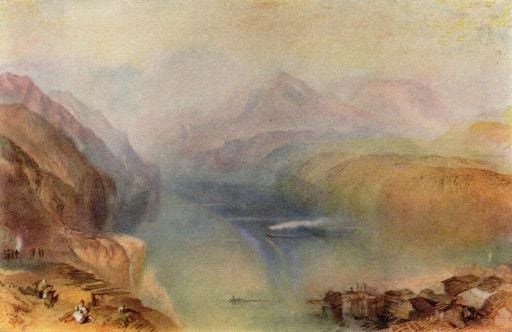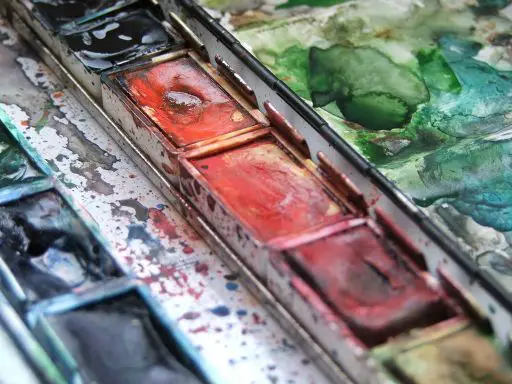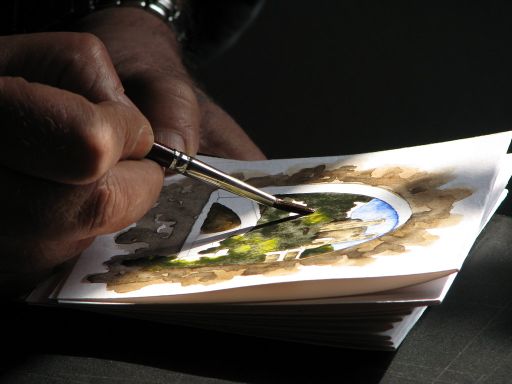Difference between revisions of "Watercolor painting" - New World Encyclopedia
({{Contracted}}) |
|||
| Line 1: | Line 1: | ||
| + | {{Contracted}} | ||
{{otheruses4|the painting method|the XM Satellite Radio channel|Watercolors (XM)}} | {{otheruses4|the painting method|the XM Satellite Radio channel|Watercolors (XM)}} | ||
Revision as of 15:50, 15 October 2007
- This article is about the painting method. For the XM Satellite Radio channel, see Watercolors (XM).
Watercolor paintingis a painting method. A watercolor is the medium or the resulting artwork, in which the paints are made of pigments suspended in a water soluble vehicle. The traditional and most common support for watercolor paintings is paper; other supports include papyrus, bark papers, plastics, vellum or leather, fabric, wood, and canvas. In East Asia, watercolor painting with inks is referred to as brush painting or scroll painting. India, Ethiopia and other countries also have long traditions.
History
Although watercolor painting is extremely old, dating perhaps to the cave paintings of paleolithic Europe, and has been used for manuscript illumination since at least Egyptian times but especially in the European Middle Ages, its continuous history as a art medium begins in the Renaissance. The German artist Albrecht Dürer (1471-1528) who painted several fine botanical, wildlife and landscape watercolors, is generally considered among the earliest exponents of the medium.
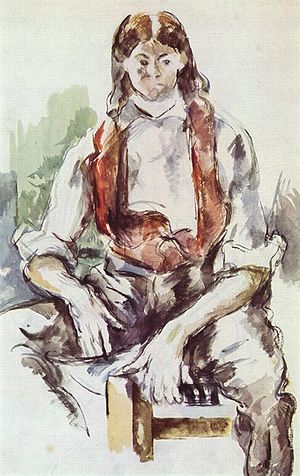
Despite this early start, watercolors were generally used by Baroque easel painters only for sketches, copies or cartoons (large scale design drawings). However, botanical and wildlife illustrations are perhaps the oldest and most important tradition in watercolor painting. Botanical illustrations became popular in the Renaissance, both as hand tinted woodblock illustrations in books or broadsheets and as tinted ink drawings on vellum or paper.
Famous Watercolorists
The three English artists credited with establishing watercolor as an independent, mature painting medium are Paul Sandby (1730-1809), often called "the father of the English watercolor," Thomas Girtin (1775-1802), who pioneered its use for large format, romantic or picturesque landscape painting, and Joseph Mallord William Turner (1775-1851), who brought watercolor painting to the highest pitch of power and refinement and created with it hundreds of superb historical, topographical, architectural and mythological paintings. His method of developing the watercolor painting in stages, starting with large, vague color areas established on wet paper, then refining the image through a sequence of washes and glazes, permitted him to produce large numbers of paintings with workshop efficiency and made him a multimillionaire in part through sales from his personal art gallery, the first of its kind. Among the important and highly talented contemporaries of Turner and Girtin were John Varley, John Sell Cotman, Anthony Copley Fielding, Samuel Palmer, William Havell and Samuel Prout. The Swiss painter Louis Ducros was also widely known for his large format, romantic paintings in watercolor.
Watercolor painting became popular in the United States during middle 19th century; the American Society of Painters in Watercolor (now the American Watercolor Society) was founded in 1866. Major 19th century American exponents of the medium included William Trost Richards, Fidelia Bridges, Thomas Moran, Thomas Eakins, Henry Roderick Newman, John LaFarge and, preeminently, Winslow Homer. Watercolor was less popular in continental Europe, though many fine examples were produced by French painters, including Eugene Delacroix, Francois-Marius Granet, Henri-Joseph Harpignies and the satirist Honore Daumier.
Among the many 20th century artists who produced important works in watercolor, mention must be made of Wassily Kandinsky, Emil Nolde, Paul Klee, Egon Schiele and Raoul Dufy; in America the major exponents included Charles Burchfield, Edward Hopper, Charles Demuth, Elliot O'Hara and above all John Marin, 80% of whose total output is in watercolor. In this period American watercolor (and oil) painting was often imitative of European Impressionism and Post-Impressionism, but significant individualism flourished within "regional" styles of watercolor painting in the 1920's to 1940's, in particular the "Ohio School" of painters centered around the Cleveland Museum of Art, and the "California Scene" painters, many of them associated with Hollywood animation studios or the Chouinard School of Art (now CalArts Academy).
Although the rise of abstract expressionism, and the trivializing influence of amateur painters and advertising or workshop influenced painting styles, led to a general decline in the popularity of watercolor painting after c.1950, watercolors continue to be utilized by important artists such as Joseph Raffael, Andrew Wyeth, Philip Pearlstein, Eric Fischl, Gerard Richter and Francesco Clemente. Modern watercolor paints are now as durable and colorful as oil or acrylic paints, and the recent renewed interest in drawing and multimedia art has also stimulated demand for fine works in watercolor. As art markets continue to expand, painting societies continue to add members and aging Baby Boomers increasingly retire to more contemplative hobbies, watercolors seem poised to enter yet another "golden age."
Materials
Paint
Commercial watercolor paints come in two grades: "Artist" (or "Professional") and "Student." Artist quality paints are usually formulated using a single pigment, which results in richer color and vibrant mixes. Student grade paints have less pigment, and often are formulated using two or more less expensive pigments. Artist and Professional paints are more expensive but many consider the quality worth the higher cost.
Paints comprise four principal ingredients:
- colorant, commonly pigment (an insoluble inorganic compound or metal oxide crystal, or an organic dye fused to an insoluble metal oxide crystal);
- binder, the substance that holds the pigment in suspension and fixes the pigment to the painting surface;
- additives, substances that alter the viscosity, hiding, durability or color of the pigment and vehicle mixture; and
- solvent, the substance used to thin or dilute the paint for application and that evaporates when the paint hardens or dries.
Thanks to modern industrial organic chemistry, the variety, saturation (brilliance) and permanence of artists' colors available today is greater than ever before.
Brushes
A brush consists of three parts: the tuft, the ferrule and the handle. The tuft is a bundle of animal hairs or synthetic fibers tied tightly together at the base; the ferrule is a metal sleeve that surrounds the tuft, gives the tuft its cross sectional shape, provides mechanical support under pressure, and protects from water the glue joint between the trimmed, flat base of the tuft and the lacquered wood handle, which is typically shorter in a watercolor brush than in an oil painting brush, and also has a distinct shape — widest just behind the ferrule and tapering to the tip.
Every watercolor painter works in specific genres and has a personal painting style and "tool discipline," and these largely determine his or her preference for brushes.
Paper
Most watercolor painters before c.1800 had to use whatever paper was at hand: Thomas Gainsborough was delighted to buy some paper used to print a Bath tourist guide, and the young David Cox preferred a heavy paper used to wrap packages. James Whatman first offered a wove watercolor paper in 1788, and the first machinemade ("cartridge") papers from a steam powered mill in 1805.
All art papers can be described by eight attributes: furnish, color, weight, finish, sizing, dimensions, permanence and packaging. Watercolor painters typically paint on paper specifically formulated for watermedia applications. Fine watermedia papers are manufactured under the brand names Arches, Fabriano, Hahnemuehle, Lanaquarelle, Saunders Waterford, Strathmore, Winsor & Newton and Zerkall; and there has been a recent remarkable resurgence in handmade papers, notably those by Twinrocker, Velke Losiny, Ruscombe Mill and St. Armand.
Techniques
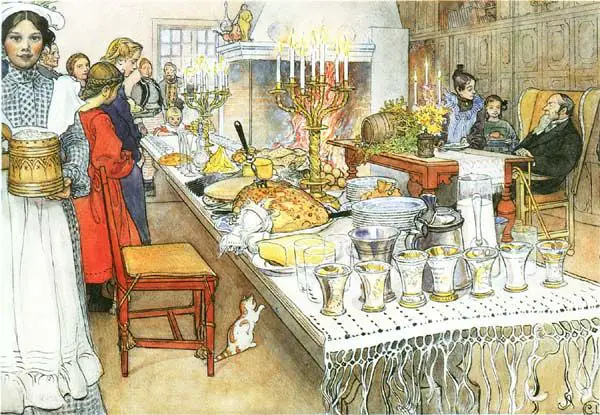
Watercolor painting has the reputation of being quite demanding; it is more accurate to say that watercolor techniques are unique to watercolor. Unlike oil or acrylic painting, where the paints essentially stay where they are put and dry more or less in the form they are applied, water is an active and complex partner in the watercolor painting process, changing both the absorbency and shape of the paper when it is wet and the outlines and appearance of the paint as it dries. The difficulty in watercolor painting is almost entirely in learning how to anticipate and leverage the behavior of water, rather than attempting to control or dominate it.
Washes and glazes
Basic watercolor technique includes washes and glazes. In watercolors, a wash is the application of diluted paint in a manner that disguises or effaces individual brush strokes to produce a unified area of color. Typically, this might be a light blue wash for the sky.
A glaze is the application of one paint color over a previous paint layer, with the new paint layer at a dilution sufficient to allow the first color to show through. Glazes are used to mix two or more colors, to adjust a color (darken it or change its hue or chroma), or to produce an extremely homogenous, smooth color surface or a controlled but delicate color transition (light to dark, or one hue to another). This method is currently very popular for painting high contrast, intricate subjects, in particular colorful blossoms in crystal vases brightly illuminated by direct sunlight.
Wet in wet
Wet in wet includes any application of paint or water to an area of the painting that is already wet with either paint or water. In general, wet in wet is one of the most distinctive features of watercolor painting and the technique that produces the most striking painterly effects.
Drybrush
At the other extreme from wet in wet techniques, drybrush is the watercolor painting technique for precision and control, supremely exemplified in many botanical paintings and in the drybrush watercolors of Andrew Wyeth. The goal is to build up or mix the paint colors with short precise touches that blend to avoid the appearance of pointilism. The cumulative effect is objective, textural and highly controlled, with the strongest possible value contrasts in the medium.
Notes
ReferencesISBN links support NWE through referral fees
[History]
- Martin Hardie. Water-Colour Painting in Britain (3 volumes: I. The Eighteenth Century; II. The Romantic Period; III. The Victorian Period.). Batsford, 1966-1968. ISBN 113184131X
- Michael Clarke. The Tempting Prospect: A Social History of English Watercolors. British Museum Publications, 1981. ASIN B000UCV0XO
- Christopher Finch. Nineteenth-Century Watercolors. Abbeville Press, 1991. ISBN 1558590196
- Christopher Finch. American Watercolors. Abbeville Press, 1991. ASIN B000IBDWGK
- Christopher Finch. Twentieth-Century Watercolors. Abbeville Press, 1988. ISBN 089659811X
- Andrew Wilton & Anne Lyles. The Great Age of British Watercolours (1750-1880). Prestel, 1993. ISBN 3-7913-1254-5
- Anne Lyles & Robin Hamlyn. British watercolours from the Oppé Collection. Tate Gallery Publishing, 1997. ISBN 1-85437-240-8
- Eric Shanes. Turner: The Great Watercolours. Royal Academy of Arts, 2001. ISBN 0-8109-6634-4
[Tutorials & Technique]
- John Ruskin. The Elements of Drawing [1857]. Watson-Guptill, 1991. ISBN 0-8230-1602-1 (Reprints from other publishers are also available.)
- Rex Brandt. The Winning Ways of Watercolor: Basic Techniques and Methods of Transparent Watercolor in Twenty Lessons. Van Nostrand Reinhold, 1973. ISBN 0-442-21404-9
- Edgar A. Whitney. Complete Guide to Watercolor Painting. Watson-Guptill, 1974. [Dover Edition ISBN 0-486-41742-5]
- Stan Smith. Watercolor: The Complete Course. Reader's Digest, 1995. ISBN 0-89577-653-7
- David Dewey. The Watercolor Book: Materials and Techniques for Today's Artist. Watson-Guptill, 1995. ISBN 0-8230-5641-4
- Pip Seymour. Watercolour Painting: A Handbook for Artists. Lee Press, 1997. ISBN 0-9524727-4-0
- Charles LeClair. The Art of Watercolor (Revised and Expanded Edition). Watson-Guptill, 1999. ISBN 0-8230-0292-6
- Royal Watercolour Society. The Watercolour Expert. Cassell Illustrated, 2004. ISBN 1844031497
[Materials]
- Jacques Turner. Brushes: A Handbook for Artists and Artisans. Design Press, 1992. ISBN 0830639756
- Sylvie Turner. The Book of Fine Paper. Thames & Hudson, 1998. ISBN 0500018715
- Ian Sideway. The Watercolor Artist's Paper Directory. North Light, 2000. ISBN 1581800347
See also
- Acrylic paint
- Oil paint
- History of painting
External links
- "Home Page". Ginnie Conaway's Watercolors. Retrieved September 3, 2007.
- "Guide to Watercolor Painting". Handprint.com. Retrieved September 3, 2007.
- Gosman, Linda M. American Artist Magazine. 2003; "Create Reality With Abstract Shapes". Watercolor-Paintings.com. Retrieved September 3, 2007.
Credits
New World Encyclopedia writers and editors rewrote and completed the Wikipedia article in accordance with New World Encyclopedia standards. This article abides by terms of the Creative Commons CC-by-sa 3.0 License (CC-by-sa), which may be used and disseminated with proper attribution. Credit is due under the terms of this license that can reference both the New World Encyclopedia contributors and the selfless volunteer contributors of the Wikimedia Foundation. To cite this article click here for a list of acceptable citing formats.The history of earlier contributions by wikipedians is accessible to researchers here:
The history of this article since it was imported to New World Encyclopedia:
Note: Some restrictions may apply to use of individual images which are separately licensed.
